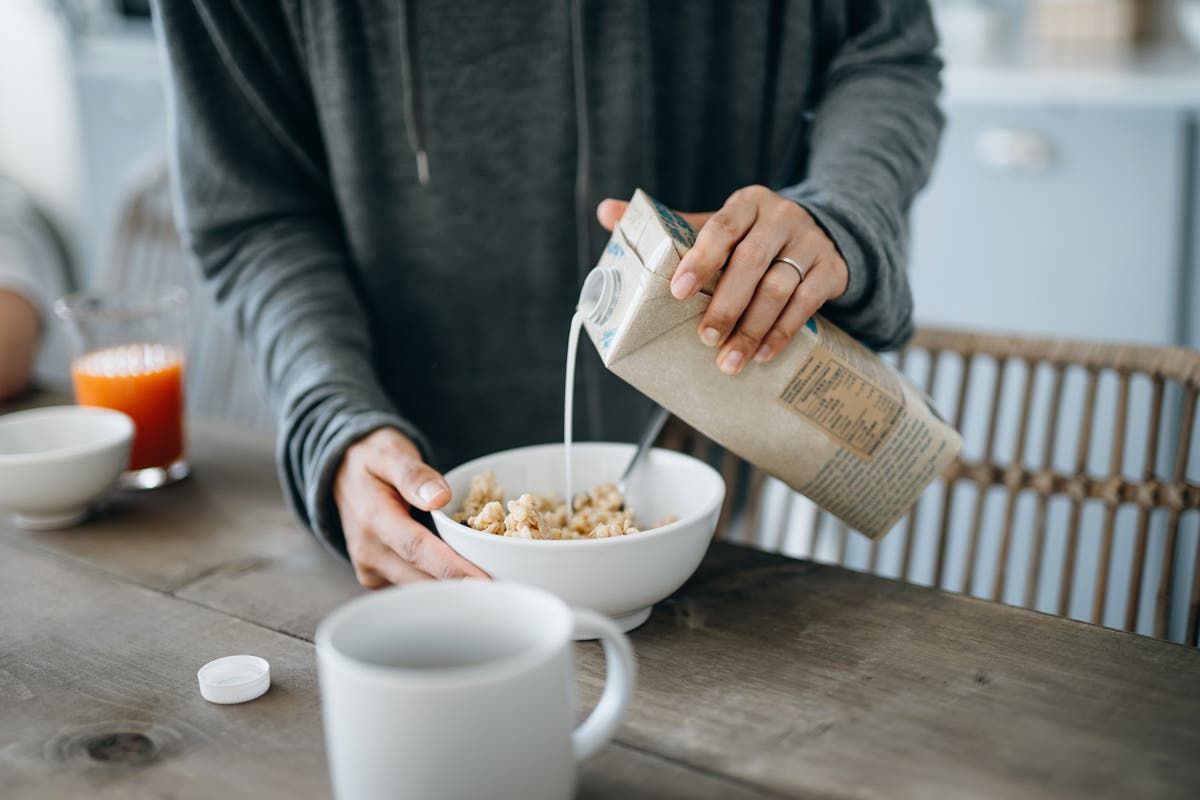“Oh God – no. other Milk I can't drink! A friend uttered these exasperated words earlier this week, followed by a deeper sigh. She, like so many people who try to do “the right thing” only to fall short, is exhausted.
She was responding to a viral video that is probably the best oat milk takedown that has ever hit the internet. Others have tried; They have all failed. But the video by actress Drea Valls, “Cow's milk when she hears that you've left the oatmeal,” in which she anthropomorphizes the former as a scorned woman, has confirmed what some already saw coming: the inevitable fall from grace of the trendiest dairy alternative on the block.
“Well, well, well,” says Valls, like a EastEnders villain complete with fur coat and fake cigarette. “Look who's come crawling back… You've had enough of her raising your blood glucose, right? I should have known what you were doing from the beginning, all those years ago. I stopped asking myself at your coast; she started to order his instead.”
The inspired monologue, which has racked up over 300,000 views on Instagram at the time of writing, contains the immortal lines: “So what's changed, hmm? You're sick of her being the toxic one now, right? she is which is bad for the environment. I feel bad for her. “Poor bitch.”
It neatly sums up the growing criticism leveled at oat milk, previously the favorite alternative milk that could do no wrong. Historically advertised as a “healthy” drink, it has recently come under fire from some nutritionists. In a high-profile interview with American businesswoman Marie Forleo that garnered 4.3 million views on TikTok, Jessie Inchauspé, the French biochemist and New York Times The bestselling author, also known as the “Glucose Goddess,” gave the following damning assessment: “Oat milk comes from oats, oats are a grain, and grains are starch. When you are [drinking] oat milk, you are [drinking] starch juice. Are [drinking] Juice with a lot of glucose. “So this leads to a big glucose spike.”
Oatly is the leading oat milk brand
(AP)
“If you have milk that comes from a cow, it's mostly made up of protein and fat,” he continues. “If you have milk that comes from a nut, it is also very, very low in starch. Those are better options in terms of glucose balancing properties. If you drink oat milk because you think it's healthier, just change it. Go back to whole milk or drink some unsweetened nut milk.”
I'll hold my hands up: as a committed cow's milk drinker (to the extent that I'll happily down a half pint of white milk as a “treat”), part of me revels in the schadenfreude of it all. . After years of a colleague double-checking that I wanted my coffee “with cruelty juice” every time I made myself a drink, holier-than-thou oat milk with a halo is finally, finally having his day of reckoning. But is it really worse for our health than cow's milk or its vegan rivals?
“It's pretty much all carbohydrates,” Sarah Carolides, a functional medicine and nutrition specialist, tells me. “There are between 15 and 20g of carbohydrates per glass, compared to around 8g of carbohydrates in a glass of cow's milk. It also has 2.5 g of protein per glass, about 4 g of unsaturated fat and about 2 g of fiber. “Cow’s milk has much more protein (between 8 and 10 g per glass) and is a complete protein source.”
Nutrition-wise, problems with oat milk can arise for three main reasons, he says: fiber; the amount of sugar/quick release carbohydrates; and the additives, emulsifiers, sugars and flavorings that some commercial brands add. “The bloating is likely due to both the fiber and the sugary carbohydrates in oat milk,” he warns. “If someone has an imbalance with the bacteria in their gut, the 'bad' bacteria can enjoy a feast on the soluble fiber and oligosaccharides that oat milk provides. “This is a type of fermentation that produces gas and causes bloating.”
Unsurprisingly, Oatly, the leading oat milk brand, which currently has a net worth of over $675 million (£529 million), is responding to claims that it is not good for your intake. glucose. “In line with the scientific community, we look at glycemic load (GL), which considers both the blood sugar level response and the effect of an average serving size,” says Caroline Orfila-Jenkins, vice president of science and technology at Oatly. “A large glass of Oatly Barista Edition (240 ml) or a splash of coffee (100 ml) are considered in the 'low category' of glycemic load and on par with cow's milk.” A 240ml glass of Oatly Barista Edition has a GL of nine, says Orfila-Jenkins. “For comparison, a typical soft drink (240ml) has a GL of around 17, which is 'average',” she adds.
Dr. Federica Amati, chief nutritionist at Zoe, the personalized nutrition company and author of Everyone should know this and Recipes for a better menopause, says that while many plant milks, including oat milk, can be highly processed and may include a wide range of ingredients you wouldn't find in your kitchen, “most people only drink them in small amounts, and Fortified versions are offered to vegans.” and children beneficial nutrients.” Unsweetened oat milk contains more sugar than some alternatives, like soy and almond milk, she says. “However, when comparing products, it is important to consider the full range of nutrients and level of processing. If you drink occasionally in your tea or coffee, choose the one you like best and if you don't have diabetes don't worry too much about sugar spikes; Your body can probably handle it.”
If you don't have diabetes, don't worry too much about sugar spikes; Your body can probably handle it.
Dr. Federica Amati, ZOE
Research by colleague Dr. Sarah Berry shows that when we consume finely ground oats (as is the case with oat milk), it causes a greater blood sugar response than after eating large whole oats. “This is normal, since the food matrix has been destroyed, making sugars more easily absorbed,” says Dr. Amati. “However, everyone responds differently to food; Something that causes a large rise in blood sugar in one person may not cause it in another. If you drink oat milk, try to choose products that do not contain many other ingredients, such as sweeteners, thickeners and emulsifiers.”
But what about the claim that oat milk has one of the lowest environmental impacts? It is generally accepted that oat milk has a lower carbon footprint than most alternatives. “Cow's milk uses much more land and water than oats and other plant-based milks per liter of milk,” says non-profit cooperative The Ethical Consumer. “It also generates significantly more greenhouse gas emissions per liter of milk than oat or other plant-based milks. Our World in Data figures indicate that oat milk uses 13 times less water and 11 times less land to produce a liter of milk compared to cow's milk.” But the Ethical Consumer adds that “considering environmental impacts comprehensively requires an understanding of production methods, which is often ignored. It is complex and videos like [Valls’s] just make the discussion binary.” And the binary is undoubtedly bad, no matter how you look at it. Just as almond milk was criticized for its high water footprint and the resulting depletion of California's groundwater sources, the story of oat milk is also more layered.
It's not the cow, it's the how… if you buy milk from an organic or regenerative dairy farm, this can be beneficial for the environment and biodiversity
Lizzie Rivera, Live Frankly
“We need to consider all environmental impact and nutrition,” Lizzie Rivera, founder of the ethical and sustainable lifestyle guide Live Frankly, tells me. “It depends on how the oats are grown; if they are not organic, there is a good chance that they have been grown with [herbicide] glyphosate, which is devastating for the environment and our health.” Oatly says its product does not contain glyphosate. According to a 2023 report from Mamavation, two in 13 popular oat milk brands in the U.S. had detectable levels of glyphosate: Malk Organic Oat Milk and Silk Extra Creamy Oatmilk.
When it comes to cow's milk, “it's not the cow, it's the how,” Rivera says. “If you buy milk from a factory farm, then the environment and animal welfare are big issues. But if milk is purchased from an organic or regenerative dairy farm, this can be beneficial for the environment and biodiversity, and cows can even be part of a system that helps extract carbon from the atmosphere and store it in the soil.”
Organic Dairy Production Could Have Environmental Benefits
(Reuters)
The Soil Association also extols the virtues of cow's milk, as long as it is organic. “Organic dairy farming uses environmentally friendly practices such as rotational grazing to ensure the herd does not overgraze fields, which keeps soils healthy and, as a result, is more effective at sequestering carbon dioxide from the atmosphere. , which helps reduce pollution. effects of climate change,” he says.
Meanwhile, most oak milk oats “are produced in intensive farming systems, often overseas, where they constitute a unique crop with significantly reduced levels of biodiversity,” the Soil Association adds. This problem of highly industrialized agriculture and the subsequent creation of monoculture – where vast areas of land are used to grow a single crop, eliminating biodiversity and having a detrimental effect on pollinators – is a problem with almost all alternatives to agriculture. vegan milk, including soy. and nut-based varieties.
But, to quote the old saying, “don't let the perfect be the enemy of the good”: plant-based milks are still better, in most environmental criteria, than the vast majority of cow's milk produced on highly industrialized farms.
Viral videos are all well and good, but whether it's a fur-wrapped woman channeling her inner dairy drama queen or a French biochemist speaking in TikTok-friendly sound bites, anything that reduces the issues to a binary debate between good and evil is probably deceptive. Like the classic Facebook relationship status from around 2006, when it comes to milk: “it's complicated.”












